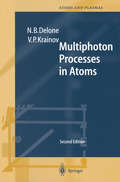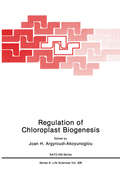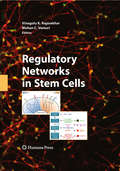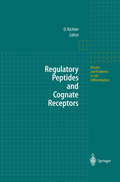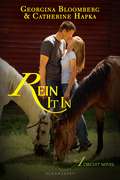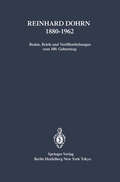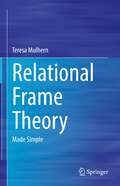- Table View
- List View
The Regulation of Cellular Systems
by Reinhart Heinrich Stefan SchusterThere is no doubt that nowadays, biology benefits greatly from mathematics. In particular, cellular biology is, besides population dynamics, a field where tech niques of mathematical modeling are widely used. This is reflected by the large number of journal articles and congress proceedings published every year on the dynamics of complex cellular processes. This applies, among others, to metabolic control analysis, where the number of articles on theoretical fundamentals and experimental applications has increased for about 15 years. Surprisingly, mono graphs and textbooks dealing with the modeling of metabolic systems are still exceptionally rare. We think that now time is ripe to fill this gap. This monograph covers various aspects of the mathematical description of enzymatic systems, such as stoichiometric analysis, enzyme kinetics, dynamical simulation, metabolic control analysis, and evolutionary optimization. We believe that, at present, these are the main approaches by which metabolic systems can be analyzed in mathematical terms. Although stoichiometric analysis and enzyme kinetics are classical fields tracing back to the beginning of our century, there are intriguing recent developments such as detection of elementary biochemical syn thesis routes and rate laws for the situation of metabolic channeling, which we have considered worth being included. Evolutionary optimization of metabolic systems is a rather new field with promising prospects. Its goal is to elucidate the structure and functions of these systems from an evolutionary viewpoint.
Regulation of Choloroplast Biogenesis (Nato Science Series A: #226)
by Joan H. Argyroudi-AkoyunoglouFrom July 28 to August 3, 1991, an International Meeting on the REGULATION OF CHLOROPLAST BIOGENESIS was held at the capsis Beach Hotel in Aghia Pelaghia, on the island of crete, Greece. The Meeting (Advanced Research Workshop-Lecture Course) was co-sponsored by NATO, FEBS and IUB, and was held under the auspices of the International society for Chloro plast Development, the Greek Ministry of Industry, Research and Technol ogy, and the National Center for Scientific Research "Demokritos". The Meeting focused on recent advances in the field of chloroplast biogenesis and the regulatory mechanisms underlined, and brought together over 120 experts and students of the field from 22 countries. The subject of chloroplast biogenesis has experienced great progress in recent years mainly thanks to the application of Molecular Biology techniques and methodology. New findings that emerge gradually unravel the regulatory mechanisms involved in the assembly, stabilization and growth of the photosynthetic units in thylakoids, the signal transduction chain leading from photoreception to gene expression, the transport of nuclear-coded proteins into stroma-soluble supramolecular enzyme complexes as well as thylakoid-bound supramolecular complexes, involved in light-energy transduction. It was the aim of this meeting to bring together experts and students coming from diverse disciplines (ranging from Botany and plant physiology to Molecular Biology, Biophysics and Biotechnology), to discuss the recent advances in the field so that thorough exchange of ideas and working hypotheses would be achieved.
Regulation of Gene Expression in Animal Viruses (Nato Science Series A: #240)
by Luis Carrasco Nahum Sonenberg Eckard WimmerViruses, being obligatory parasites of their host cells, rely on a vast supply of cellular components for their replication, regardless of whether infection leads to cell death or to the state of persistence. Animal viruses are providing scientists with relatively simple models to study the molecular biology of genome replication and gene expression. Whereas viruses use, in general, pathways of macromolecular biosynthesis common to the host cell, they have a cunning ability to adopt unusual mechanisms of gene expression and gene replication, provided these special pathways offer an advantage in competition for cellular resources. Any study of viral gene expression and replication is likely to lead also to new insights in cellular metabolism. The discoveries of cis-acting regulatory elements in transcription, the phenomenon of splicing of pre mRNA, and cap-dependent and cap-independent initiation of translation may be cited as examples. In addition, animal virus genomes contain elements and encode proteins that are very useful for the design of vectors for gene cloning and expression in mammalian cells. Apart from the basic interest in their biology, viruses have gained notoriety, of course, because they are pathogens. Human animal viruses may cause diseases ranging from the deadly (AIDS) to the benign (common cold). All studies on animal viruses potentially lead to the development of tools for their control, be it through prevention by immunization or treatment with antiviral drugs. Finally, viruses have yielded invaluable reagents in molecular biology as, for example, the vaccinia virus vector for the expression of foreign genes.
Regulation of Plasma Low Density Lipoprotein Levels Biopharmacological Regulation of Protein Phosphorylation Calcium-Activated Neutral Protease Microbial Iron Transport Pharmacokinetic Drug Interactions (Progress in Clinical Biochemistry and Medicine #5)
by William R. Bartle Volker Braun John M. Dietschy Yasufumi Emori Masatoshi Hagiwara Hiroyoshi Hidaka Shinobu Imajoh Hiroshi Kawasaki Jonathan B. Meddings Shigeo Ohno Koichi Suzuki Scott E. Walker Günther Winkelmann Nancy E. WinsladeCholesterol is essential for normal cellular function. It is found in all cells of the body and is a major constituent of cell membranes. In addition, certain specialized tissues use cholesterol as the basic substrate for the synthesis of more complicated sterols such as bile acids and the steroid hormones. Like most lipids cholesterol has a very low solubility in water. Therefore, in order for these molecules to be transported be tween different organs of the body a series of lipid carriers known as lipoproteins has evolved. Over the last several years epidemiological evidence has accumulated suggest ing a strong relationship between the risk of atherosclerosis and high plasma concen trations of one of these lipoproteins, low density lipoprotein (LDL) 1). Thus, in popula tions with high plasma concentrations of LDL-cholesterol a correspondingly high incidence of vascular disease is seen. Since it has been demonstrated that reducing the steady-state plasma LDL-cholesterol concentration produces a proportional decrease in the risk of developing atherosclerosis 2), a major effort is now underway to develop safe and effective lipid lowering agents. In the past, these efforts have been hampered by a lack of knowledge concerning the physiological regulation of the plasma LDL-cholesterol concentration. However, recently there have been several major advances in these areas and it is now possible to precisely determine those factors that have the greatest effect on either increasing or decreasing the plasma LDL-cholesterol concentration.
Regulation of Smooth Muscle Contraction (Advances in Experimental Medicine and Biology #304)
by Robert S. MorelandSixth Annual Graduate Hospital Research Symposium REGULATION OF SMOOTH MUSCLE PROGRESS IN SOLVING THE PUZZLE Every so often a scientific conference comes at a time when everyone has new and exciting information, when old "dogmas" do not seem to be as well established, and when speakers and participants alike are ready to challenge interpretations of old and new experimental data. This was such a conference. What turns on a smooth muscle cell? The precise answer to this question has eluded scientists for much longer than I have been involved in the field. We know that an increase in cytosolic calcium is necessary and we know that phosphorylation of the 20 kDa myosin light chain is an important step in the process. We do not know if other processes are necessary for the initiation and lor maintenance of a smooth muscle contraction nor do we know if other processes modulate the regulation of contraction. The goal of the symposium on which this volume is based was to explore the most current hypotheses for the answers to these questions. I believe that after reading the chapters included in this volume, you will agree that this goal was achieved. The importance of calcium and calmodulin dependent myosin light chain phosphoryla tion in the regulation of smooth muscle contraction was reinforced by many presentations. However, the status of myosin light chain phosphorylation as a simple calcium dependent switch came under serious suspicion.
Regulatory Mechanisms in Insect Feeding
by Reg F. Chapman Gerrit De BoerThe only book to deal comprehensively with insect feeding was published by C. T. Brues in 1946. His Insect Dietary was an account of insect feeding habits. Since that time there has been a revolution in biology, and almost all aspects of our understanding of insect feeding have expanded to an extent and into areas that would have been unthinkable in Brues' day. Yet, our book does not replace Insect Dietary but, instead, complements it, because our aim is to bring together information on the mechanisms by which food quality and quantity are regulated. We deliberately focus attention on the feeding process; to include food-finding would have required a much larger book and would have moved the focus away from more proximate mechanisms. This book is dedicated to the late Vincent G. Dethier. As a pioneer in studying the physiological basis of animal behavior, he focused on regulation of feeding in flies and caterpillars. His work on the blowfly, together with that by his many students and co-workers, still provides the most completely described mechanism of insect feeding. The citation of his work in almost every chapter in this book illustrates the importance of his findings and ideas to our current understanding of regulation of insect feeding. The authors in this book provide many innovative and stimulating ideas typifying Dethier's approach to the study of feeding be havior.
Regulatory Mechanisms of Neuron to Vessel Communication in the Brain (Nato ASI Subseries H: #33)
by Fiorenzo Battaini Stefano Govoni Maria S. Magnoni Marco TrabucchiProceedings of the NATO Advanced Research Workshop on Regulatory Mechanisms of Neuron to Vessel Communication in the Brain held in Salo, Italy, September 3-8, 1988
Regulatory Networks in Stem Cells (Stem Cell Biology and Regenerative Medicine)
by Vinagolu K. Rajasekhar Mohan C. VemuriStem cells appear to be fundamental cellular units associated with the origin of multicellular organisms and have evolved to function in safeguarding the cellular homeostasis in organ t- sues. The characteristics of stem cells that distinguish them from other cells have been the fascinating subjects of stem cell research. The important properties of stem cells, such as ma- tenance of quiescence, self-renewal capacity, and differentiation potential, have propelled this exciting ?eld and presently form a common theme of research in developmental biology and medicine. The derivation of pluripotent embryonic stem cells, the prospective identi?cation of multipotent adult stem cells, and, more recently, the induced pluripotent stem cells (popularly called iPS) are important milestones in the arena of stem cell biology. Complex networks of transcription factors, different signaling molecules, and the interaction of genetic and epi- netic events constantly modulate stem cell behavior to evoke programming and reprogramming processes in normal tissue homeostasis during development. In any given cellular scenario, the regulatory networks can pose considerable complexity and yet exert an orderly control of stem cell differentiation during normal development. An aberration in these ?nely tuned processes during development usually results in a spectrum of diseases such as cancers and neurological disorders. Thisunderscorestheimminentneedforamorecompleteunderstandingofmolecular mechanisms underlying the regulatory circuitries required for stem cell maintenance. Overthepast3–5years,adiversegroupofbenchandphysicianscientistshaveprospectively enhanced our knowledge of stem cell biology. These studies are unveiling many unrecognized or previously unknown fundamentals of developmental biology.
Regulatory Peptides and Cognate Receptors (Results and Problems in Cell Differentiation #26)
by Dietmar RichterRehabilitation of the Brain-Damaged Adult (Nato Science Series B:)
by Gerald Goldstein Leslie RuthvenBasic Issues in Rehabilitation of the Brain Damaged Definitions Because of the vagueness surrounding the term brain damage, it is nec essary at the outset to define the population to which this book may have some application. Although it is usual to speak of the brain damaged patient in a general way, the conditions referred to cover a variety of specific disorders. In this book we will be discussing only individuals who become brain-damaged as adults. We will be ad dressing ourselves specifically to adults who have sustained demon strable, structural brain damage. Those conditions in which brain dys function is a possible etiological agent, such as a number of functional psychiatric disorders, will not be considered. Thus the entire topic of mental retardation and early life brain damage will not be treated here, nor the many problems associated with minimal brain damage syn dromes in school age children. Modern psychiatric thinking has tended to blur the distinction between the so-called functional and organic disorders (d. Shagass, Gershon, & Friedhoff, 1977), but we would ad here to the view that the patient with structural brain damage contin ues to present relatively unique assessment and treatment problems. Furthermore, the emphasis of this book will be placed on individ uals with nonprogressive, chronic brain damage.
Rehabilitation Science in Context (Advances in Experimental Medicine and Biology #1096)
by Mieczyslaw PokorskiThe focus of this book lies on novel aspects of rehabilitation medicine used as a treatment tool in both physical and mental spheres.The articles cover a diverse spectrum, such as rehabilitation in orthopedic pathologies, the exemplary of which is knee joint degeneration, in perioperative metastatic cancer diseases, or in neural degeneration requiring a transplant of donor nerve fibers into the defunct nerve. Advanced research studies involving proprioceptive neuromuscular facilitation, photobiomodulation, or yoga meditative techniques to regain functional ability are dealt with. The topic is expanded by a comprehensive picture of chosen molecular, genetically underpinned, diagnostics in hepatitis C infections and of novel ideas in drug design holding a curative promise in central neurodegeneration, such as development of brain-blood-barrier permeable oleic derivatives of the hydrophilic dopamine compound. The emerging rehabilitative modes and applications are posed to influence future health care delivery.The state-of-the art research is addressed to scientists, clinicians, therapists, and allied health care professionals.
Rein It In: An A Circuit Novel (The A Circuit)
by Catherine Hapka Georgina BloombergThe A circuit's notorious new gossip blog is all anyone can talk about. Rumors about Kate are threatening her horse show career and her relationship with Fitz. Zara is mad when her riding ability is questioned. Tommi is riding the high of selling the horse she trained all summer. But the blog is speculating about her next training prospect . . . and a new guy she meets at the first show of the fall season. He's a star athlete, but is he boyfriend material? As the exclusive series of fall horse shows known as Indoors kicks into high gear, so does the gossip. And when the blogger posts a fake scandal about Zara's rock star father, she knows things have gone too far. And she has a plan to out the snarky blogger once and for all. . . .
Reindeer: An Arctic Life
by Tilly SmithIn this enchanting book, self-confessed ‘reindeer geek’ Tilly Smith leads the reader through the extraordinary natural history of the reindeer with charming anecdotes about her own Scottish herd. From flat ‘clown-like’ hooves to warm furry noses and majestic antlers, fall in love with nature’s most adaptable arctic mammal.
Reindeer 1 (UEB uncontracted)
by Adrian FarnsworthThis page shows a tactile image of one of Santa's reindeer helpers seen from the side and facing to the left.
Reindeer 2 (UEB uncontracted)
by Adrian FarnsworthThis page shows a Large Print image of one of Santa's reindeer helpers seen from the side and facing to the left.
Reindeer and Caribou: Health and Disease
by Morten Tryland Susan KutzThis book is a comprehensive presentation of health and diseases in reindeer and caribou, or just Rangifer, a key Circumarctic species with broad social and ecological value. It is an essential reference for anyone interested in the biology and health of wild or semi-domesticated reindeer and caribou, and is more broadly relevant for those with interests in other species of free-ranging and captive cervids. Beginning with a general introduction to Rangifer as a species, it then focuses on Rangifer "health" as a concept and describes the determinants of health at an individual and population level. Chapters cover a range of topics from nutrition and feeding to stress, non-infectious and infectious diseases, meat hygiene, capture and restraint, diagnosis and treatment of health issues, and finally, potential impacts of climate change on health of Rangifer. Reindeer and Caribou: Health and Disease compiles extensive research and experience-based information on issues ranging from drug doses for chemical immobilization, blood chemistry values, and raising an orphaned calf. In addition, it contains hundreds of high quality colour illustrations that contribute to its value as a diagnostic resource for recognizing various parasites, pathogens and signs of disease, both in live and dead animals. Each chapter is followed by a comprehensive list of references and a list of contact information for all the contributors, identifying world experts in the different areas of health for this circumpolar and fascinating species. This book is compulsory reading and an indispensable resource for anyone dealing with health in reindeer and caribou, including veterinarians, wildlife biologists and managers, reindeer herders/game ranchers, zoological husbandry personnel, and students with wildlife health.
Reindeer and Caribou: Health and Disease
by Morten Tryland Susan J. KutzThis book is a comprehensive presentation of health and diseases in reindeer and caribou, or just Rangifer, a key Circumarctic species with broad social and ecological value. It is an essential reference for anyone interested in the biology and health of wild or semi-domesticated reindeer and caribou, and is more broadly relevant for those with interests in other species of free-ranging and captive cervids. Beginning with a general introduction to Rangifer as a species, it then focuses on Rangifer "health" as a concept and describes the determinants of health at an individual and population level. Chapters cover a range of topics from nutrition and feeding to stress, non-infectious and infectious diseases, meat hygiene, capture and restraint, diagnosis and treatment of health issues, and finally, potential impacts of climate change on health of Rangifer. Reindeer and Caribou: Health and Disease compiles extensive research and experience-based information on issues ranging from drug doses for chemical immobilization, blood chemistry values, and raising an orphaned calf. In addition, it contains hundreds of high quality colour illustrations that contribute to its value as a diagnostic resource for recognizing various parasites, pathogens and signs of disease, both in live and dead animals. Each chapter is followed by a comprehensive list of references and a list of contact information for all the contributors, identifying world experts in the different areas of health for this circumpolar and fascinating species. This book is compulsory reading and an indispensable resource for anyone dealing with health in reindeer and caribou, including veterinarians, wildlife biologists and managers, reindeer herders/game ranchers, zoological husbandry personnel, and students with wildlife health.
Reindeer Hunters of the Ice Age in Europe: Economy, Ecology, and the Annual Nomadic Cycle
by Laure FontanaThis book undertakes a thorough study of Reindeer in the Upper Pleniglacial and Tardiglacial societies in France. It addresses two main topics – the economy of animal resources within the societies and the exploitation of Reindeer organized within the annual cycle, in terms of space and time, between 30,000 and 14,000 cal BP in France. The author proposes an analysis and hypothesis regarding the economy of animal resources and the nomadic cycle of the last Paleolithic hunter-gatherer societies, in order to identify a “Reindeer system.”The author discusses the relationship between Reindeer and human mobility and offers some conclusions regarding the annual cycles of nomadism. The volume scrutinizes the distinct eco systems in three regions and its effects on the movements of both human and animal. This book is of interest to zooarchaeologists and prehistorians.
Reindeer Husbandry and Global Environmental Change: Pastoralism in Fennoscandia (Earthscan Studies in Natural Resource Management)
by Tim HorstkotteThis volume offers a holistic understanding of the environmental and societal challenges that affect reindeer husbandry in Fennoscandia today. Reindeer husbandry is a livelihood with a long traditional heritage and cultural importance. Like many other pastoral societies, reindeer herders are confronted with significant challenges. Covering Norway, Sweden and Finland – three countries with many differences and similarities – this volume examines how reindeer husbandry is affected by and responds to global environmental change and resource extraction in boreal and arctic social-ecological systems. Beginning with an historical overview of reindeer husbandry, the volume analyses the realities of the present from different perspectives and disciplines. Genetics, behavioural ecology of reindeer, other forms of land use, pastoralists’ norms and knowledge, bio-economy and governance structures all set the stage for the complex internal and externally imposed dynamics within reindeer husbandry. In-depth analyses are devoted to particularly urgent challenges, such as land-use conflicts, climate change and predation, identified as having a high potential to shape the future pathways of the pastoral identity and productivity. These futures, with their risks and opportunities, are explored in the final section, offering a synthesis of the comparative approach between the three countries that runs as a recurring theme through the book. With its richness and depth, this volume contributes significantly to the understanding of the substantial impacts on pastoralist communities in northernmost Europe today, while highlighting viable pathways to maintaining reindeer husbandry for the future. This book will be of great interest to students and scholars of both the natural and social sciences who work on natural resource management, global environmental change, pastoralism, ecology, social-ecological systems, rangeland management and Indigenous studies.
Reindeer Husbandry and Global Environmental Change: Pastoralism in Fennoscandia (Earthscan Studies in Natural Resource Management)
by Tim Horstkotte Øystein Holand Jouko Kumpula Jon MoenThis volume offers a holistic understanding of the environmental and societal challenges that affect reindeer husbandry in Fennoscandia today. Reindeer husbandry is a livelihood with a long traditional heritage and cultural importance. Like many other pastoral societies, reindeer herders are confronted with significant challenges. Covering Norway, Sweden and Finland – three countries with many differences and similarities – this volume examines how reindeer husbandry is affected by and responds to global environmental change and resource extraction in boreal and arctic social-ecological systems. Beginning with an historical overview of reindeer husbandry, the volume analyses the realities of the present from different perspectives and disciplines. Genetics, behavioural ecology of reindeer, other forms of land use, pastoralists’ norms and knowledge, bio-economy and governance structures all set the stage for the complex internal and externally imposed dynamics within reindeer husbandry. In-depth analyses are devoted to particularly urgent challenges, such as land-use conflicts, climate change and predation, identified as having a high potential to shape the future pathways of the pastoral identity and productivity. These futures, with their risks and opportunities, are explored in the final section, offering a synthesis of the comparative approach between the three countries that runs as a recurring theme through the book. With its richness and depth, this volume contributes significantly to the understanding of the substantial impacts on pastoralist communities in northernmost Europe today, while highlighting viable pathways to maintaining reindeer husbandry for the future. This book will be of great interest to students and scholars of both the natural and social sciences who work on natural resource management, global environmental change, pastoralism, ecology, social-ecological systems, rangeland management and Indigenous studies.
Reindeer Recovery: Special 3 (Animal Ark)
by Lucy DanielsHelping animals, having fun! A cracking bumper-length Christmas special with two stories in one! Amelia and Sam are excited because it is nearly Christmas. This year's celebrations are going to be the best ever - because real reindeer are visiting the village of Welford! When one of the reindeer falls ill with pneumonia, Amelia and Sam help the vets at Animal Ark nurse it back to health - and just in time, too. Because when a heavy snowfall blocks the roads, the only way to get poorly pets to Animal Ark is by sleigh! A brilliant animal series from multi-million-selling author Lucy Daniels, loved by parents and reimagined for a new generation of children!"I remember reading these books as a child myself. Now buying them for my own daughter. . . Delightful stories!""I love this series of books. They made me realise how special animals are!"Perfect for fans of Holly Webb and Magic Animal Friends!
Reinhard Dohrn 1880–1962: Reden, Briefe und Veröffentlichungen zum 100. Geburtstag
by Christiane GroebenReinventing Fisheries Management (Fish & Fisheries Series #23)
by T. J. Pitcher P. Hart D. PaulyJudged by a dismaying track record and a consequent downturn in the reputation of fisheries scientists, fisheries management is certainly a candidate for calls for reinvention, with many of the world leaders in this area holding the view that no fishery has ever been properly understood or managed. With fisheries science in a state of flux, this extremely important book seeks a new paradigm that will place this flux of ideas in perspective and help us to choose those that will make fisheries management work. The book was planned at a symposium of over 100 fishery researchers at the Fisheries Centre, University of British Columbia, Vancouver, Canada and is organized into five parts: Why does Fisheries Science Need Reinventing?; New Policies; The Role of the Social Sciences; Ecology; Modelling. Carefully integrated and edited by three of the world's leading fishery scientists, this stimulating book should find a place on the shelves of all fishery scientists throughout the world. It will be an invaluable reference source to those studying fish biology, fisheries and oceanography and all those involved in fisheries policy decisions in government and university research establishments.
Reinventing the Chicken Coop: 14 Original Designs with Step-by-Step Building Instructions
by Kevin McElroy Matthew WolpeThe step-by-step instructions and full-color photographs of these inspiring coops will delight both first-time builders and veteran chicken farmers alike.
Relational Frame Theory: Made Simple
by Teresa MulhernRelational Frame Theory: What is it? Why is it important? How can I use it? This book dispels the confusion surrounding Relational Frame Theory and provides an easy-to-understand briefing of Relational Frame Theory and its’ components, with examples to enhance and ease understanding. Recent research has indicated that Relational Frame Theory may form the cornerstone of language and intelligence and this textbook integrates this information into an easily digestible format, considering the importance of each relational frame from coordination to analogy. Relational Frame Theory provides a potentially useful framework for teaching language and academic skills and the current textbook provides some examples of how to do this and offers some considerations for future research in this area. This book makes Relational Frame Theory easy to understand and, unlike previous books, assumes no prior knowledge of the theory amongst readers and clarifies some of the jargon used within this body of work. This book provides the most up-to-date outline of previous work within Relational Frame Theory and gives an overview of how this theory could be applied within psychology. To date, no previous book has attempted to integrate research, application and an easy-to-understand overview of the theory together – this book aims to integrate all of these aspects into one easily comprehensible guide. The current textbook is aimed towards graduate students and practitioners of applied behavior analysis. Given the proposed changes to the Behavior Analysis Certification Board which will focus more on Relational Frame Theory than in the past, a book of this nature will be helpful for those pursuing certification and may also be helpful for use within the applied field.
